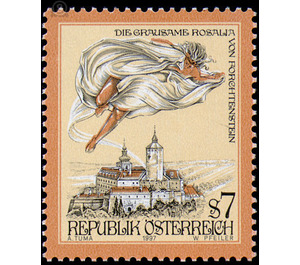Myths and legends - Austria / II. Republic of Austria 1997 - 7 Shilling
Theme: Mythology
| Country | Austria / II. Republic of Austria |
| Issue Date | 1997 |
| Face Value | 7.00 |
| Color | green pink |
| Printing Type | combination printing |
| Stamp Type | Definitive |
| Item Type | Stamp |
| Chronological Issue Number | 1555 |
| Chronological Chapter | OOS-OE2 |
| SID | 709186 |
| In 120 Wishlists | |
The definitive stamp "The cruel Rosalia of Forchtenstein" was published as part of the definitive stamp series "Legends and legends from Austria". The brand image shows the "spirit of the Rosalia" over the castle Forchtenstein. The legend "The Cruel Burgundy" Rosalie, the wife of the peace-loving Prince Giletus of Forchtenstein, was a cruel woman. Once the prince had gone to war, and Rosalie ("Sallah") felt herself an autocratic burgess, she deprived and oppressed the peasants in the most heartless manner, and many of them found - since they could not pay, or simply the displeasure of Princess awakened - starving to death in the black castle tower. After his return, the lord of the castle held court over his wife. Like those tortured by the cruel woman, she was tied to a rope and lowered into the black tower, where she had to starve to death, hovering over the corpses of her victims. Every quarter of an hour the castle guard stepped in front of a tower hatch and called down: "Sallah he!" And always a heartbreaking scream came from the depths. On the eighth day, however, the tower had become quiet. Since then, at midnight, Rosalia's ghost appeared ghostly around the black tower of Forchtenstein. For centuries and centuries, the castle guard always grabbed the rifle and called to the tower in a stretched tone: "Sallah he!", Whereupon the haunting disappeared. Only in the 15th century, when a lord of the castle had the Rosalien chapel built for atonement on a nearby mountain, the spirit of the castle woman was saved forever. As far as the legend of the cruel Rosalia of Forchtenstein. An essential characteristic of the legends in themselves is the claim to truth and the pedagogical purpose, which again and again determines the happening. In our case, the pedagogical tone of the legend is not directed to one or more people from the people who have done something wrong, but to a princess who has been lacking in the role of the people in her deputy regency. The history of Forchtenstein Castle: Forchtenstein - around the turn of the 13th / 14th centuries Built as a frontier house in the 18th century, it was probably very intimately connected with the Lower Austrian area (Wiener Neustadt) from the very beginning. This powerful complex on a dolomite rock was used to protect and control the important road link Sopron (Hungary, German name: Ödenburg) and Wiener Neustadt (Lower Austria). From 1352 to 1445 it is under the rule of the Mattersdorf counts. Finally county and castle (1445) come by pledge and in 1447 by purchase to Duke Albrecht VI. from Austria, who finally passes it on to his brother, later Emperor Frederick III. Today, the castle is owned by the Esterhazy family.


